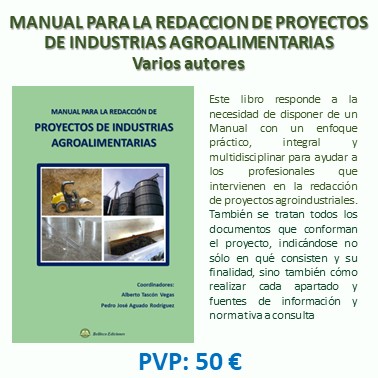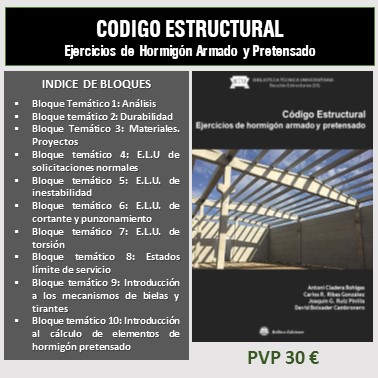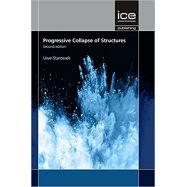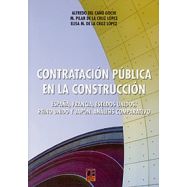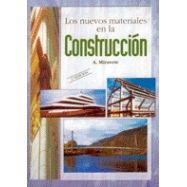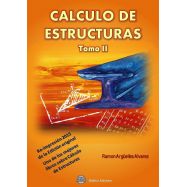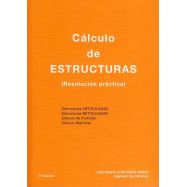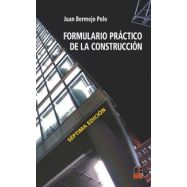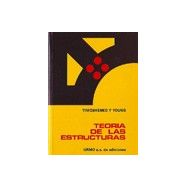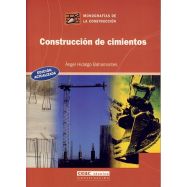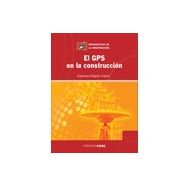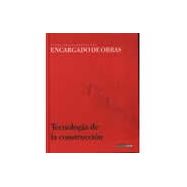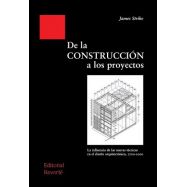Ningún producto
Materias
- BELLISCO EDICIONES. Nuestro Fondo Editorial
- FONDOS EDITORIALES EN DISTRIBUCION
- LIBROS TECNICOS EN INGLES
- ARQUITECTURA - URBANISMO
- AUTOMOCION - MOTORES - VEHICULOS
- AVIONICA - AERONAUTICA
- CALIDAD - EMPRESARIALES - GESTION
- CIENCIAS EXACTAS - MATEMATICAS
- CIENCIAS NATURALES Y APLICADAS
- CIENCIAS DE LA TIERRA - INGENIERIA DEL SUELO
- DICCIONARIOS TECNICOS
- ESTRUCTURAS - CONSTRUCCION
- Acústica (aislamiento, ruidos, vibraciones)
- Análisis de estructuras, resistencia de materiales, elasticidad, cálculo matricial
- Edificación
- Estructuras de Hormigón
- Estructuras Metálicas
- Estructuras de Madera
- Estructuras Mixtas
- Estructuras y Construcción en General
- Novedades Estructuras-Construccion
- rehabilitacion y restauracion
- Formación Profesional: Oficios en construccion, edificación y obras
-
- FORMACION PROFESIONAL
- HIDRAULICA - INGENIERIA SANITARIA - AGUAS
- INGENIERIA CIVIL - OBRAS PUBLICAS
- INGENIERIA MECANICA E INDUSTRIAL
- INSTALACIONES . GENERALES, EN EDIFICACION E INDUSTRIALES
- MATERIALES
- MEDIO AMBIENTE
- NORMATIVA
- OPOSICIONES
- PREVENCION DE RIESGOS LABORALES
- PROGRAMAS INFORMATICOS DE CALCULO
- TECNOLOGIA DE LOS ALIMENTOS: Industrias: Conservación, envasado y cadenas alimentarias
- TELECOMUNICACIONES - INFORMATICA - TECNOLOGIA DE LA INFORMACION
- OUTLET DE BELLISCO: Descuentos de hasta el 80%
- RELIGION, TEOLOGIA, MORAL Y ESPIRITUALIDAD
- VARIOS
- OFERTAS
- PROMOCIONES
- NEWSLETTER
- CATEGORIAS DESTACADAS
- ULTIMAS NOVEDADES BELLISCO
- ARQUITECTURA SOSTENBILE
- URBANISNO
- MATEMATICAS EN GENERAL
- AGRONOMOS-AGRICULTURA-FORESTALES
- ELECTROMAGENTISMO-ELECTRONICA-ELECTRICIDAD
- INGª Y MECÁNICA DEL SUELO. CIMENTACIONES
- TOPOGRAFIA, FOTOGRAMETRÍA, GEODESIA
- EDIFICACION
- ANALISIS DE ESTRUCTURAS, RESISTENCIA DE MATERIALES, ELASTICIDAD, CALCULO MATRICIAL
- OFICIOS VARIOS
- ABASTECIMIENTO Y DISTRIBUCION DE AGUA
- PUENTES
- TUNELES Y OBRAS SUBTERRANEAS
- MAQUINAS Y MECANISMOS
- SOLDADURA
- CLIMATIZACION
- INSTALACIONES DE AGUA
- INSTALACIONES ELECTRICAS CIENCIA E INGENIERIA DE MATERIALES
- ENERGIAS RENOVABLES
- DESARROLLO SOSTENIBLE
- INFORMATICA-SISTEMAS-FORMACION-PROGRAMAS
-
SHELL STRUCTURES IN CIVIL AND MECHANICAL ENGINEERING: THEORY AND ANALYSIS, 2ND EDITION
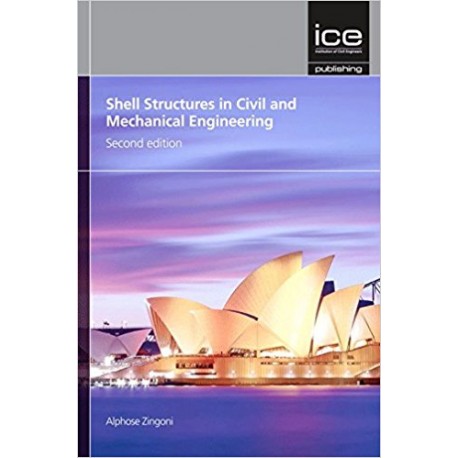 Ver más grande
Ver más grande Referencia: Código 07539
Enero de 2018 - Alphose Zingoni - Refª 7539
Alphose Zingoni
Enero de 2018 Páginas: 464
Código 7539 ISBN/EAN: 9780727760289
Description
Shell Structures in Civil and Mechanical Engineering comprehensively covers the theories governing the membrane and bending behaviour of thin elastic shells. It applies these theories to obtain practical solutions for a wide variety of shell structures encountered in the civil and mechanical engineering disciplines. Through a detailed examination of the mathematical solutions, the treatment reveals important insights on the mechanics of the shell, allowing the designer to make more informed choices.
Shell Structures in Civil and Mechanical Engineering:
• presents a thorough discussion of the applicability and limitations of the membrane hypothesis in the context of the more general bending theory of shells
• develops the membrane and bending theories of shells, and presents a wealth of closed-form mathematical results for a wide range of shell structures, including junction problems
• includes design considerations and parametric findings for domes, shell roofs, cooling towers, pressure vessels, tanks, new shell forms for liquid containment and novel multi-shell assemblies
• presents the fundamentals of shell buckling and of finite element modelling of shells.
This new edition is intended for civil and structural engineers involved with the design of domes, architectural shell roofs, industrial barrel roofs, cooling towers, silos, elevated water reservoirs, liquid-containment structures at water treatment works, egg-shaped sludge digesters, oil-storage tanks, chemical storage vessels, and pipelines for water, oil and gas.
It will also be of interest to mechanical and industrial engineers involved with the design of pressure vessels, boilers, nuclear containment vessels and associated piping. The rigorous derivation of theory and inclusion of new findings will appeal to researchers and postgraduate students in these fields.
Contents
1. Introduction
2. Membrane theory of shells of revolution
3. Membrane solutions for various shells of revolutions under axisymmetric loading
4. Solution approach for shells of revolution under non-axisymmetric loading
5. Axisymmetric bending of circular cylinders
6. Axisymmetric bending of general shells of revolution
7. Flexibility analysis of shell structures and multi-shell assemblies
8. Parametric studies of membrane and edge effects in containment shells of revolution
9. Membrane theory and solutions for general cylinders
10. Membrane theory and solutions for shells of arbitrary shape
11. Buckling of thin shells of revolution
12. Finite element analysis of shells of revolution
13. Design considerations for shell structures
Prof. Nary Narayanan, Engineering Consultant, London:
Design of shell structures is and will remain a specialist area. Many of the problems in this form of structures are formulated by differential equations for which exact solutions cannot be found. The mathematics involved tends to frighten many practising engineers. They prefer close formed solutions. The first edition of ‘Shell structures’ published in 1997 provided such helpful data. After a passage of some 20 years Professor Zingoni is refreshing the book and the new features are welcome. Apart from some reordering of the contents the new edition includes sections on non-conventional shell forms for liquid containment applications and new chapters on buckling of thin shells, finite element analysis and design consideration for shells. The main thrust of the book remains the development of simplified mathematical theory and presentation of closed-form analytical solutions for a wide variety of shell problems.
The subject is covered in thirteen chapters. The introductory Chapter 1 traces the historical development of shell theory and explains the way shells resist applied loads. The next three Chapters develop the membrane theory of shells of revolution. Chapters 5 and 6 present theories of axisymmetric bending of cylindrical shells and general shells of revolution. Flexibility formulation for shells is explained in Chapter 7. Parametric studies for some spherical tanks and domes are presented in Chapter 8. Membrane theory of general cylinders and shells of arbitrary shape are covered in Chapters 9 and 10. Chapter 11 deals with approximate theory of buckling. The finite-element formulation for shells is outlined in Chapter 12.The final Chapter is devoted to design considerations for concrete and steel shells. Eurocode design criteria and guidelines of the American Petroleum Institute are reviewed.
As in the first edition all information (formulae and Figures) is very clearly presented.
The book should appeal to academics, post graduate students and practitioners.
Professor Zingoni’s efforts deserve a wide audience and success.
Professor D A Nethercot OBE, FREng, FTSE, NAE Emeritus Professor of Civil Engineering Imperial College London, UK:
Curved roofs, cooling towers, pressure vessels and arch dams are some of the most visually attractive and geometrically intriguing of engineering structures. Unsurprisingly, their structural behaviour is also complex, providing numerous opportunities for the analyst to test his skill against the intricacies of the governing mathematics. As a result, shell theory has been fertile ground for the development of ever more ingenious solution techniques, including, over the past half century, increasing reliance on numerical methods. Despite the enormous power of techniques such as the finite element method, aided by equally substantial developments in computing capability, the fascination and value of a closed form solution that permits the direct relationships between the key governing parameters and the main measures of response to be directly associated with one another remains.
It is these relationships between key problem descriptors - thickness, curvature, support conditions etc. - and the deformations and stresses induced by the applied loading that forms the core of this book. The governing mathematics is often very challenging but Professor Zingoni succeeds in simplifying this and extracting the key results and physical insights so that the reader does not require mastery of all the mathematical techniques in order to understand and to use the material.
The first edition of this book produced some 20 years ago has become the standard reference on shell structures and an invaluable source of background and explanation of the design provisions that are now finding their way into Design Codes around the world. Even when numerical analysis is to be employed - perhaps to check the significance of material and/or geometric nonlinearities that cannot be addressed by analytical methods - use of closed form solutions to assess the relative importance of individual parameters and to identify which combinations should be subject to more precise analysis is necessary. Faced with a commission that requires consideration of some form of shell structure, design offices around the world should reach for this book as the essential basis for understanding the subject. It goes without saying that postgraduate courses on shells and researchers in the subject area should also do the same.
Prof. Tim Ibell, Cambridge University, Past President of the Institution of Structural Engineers
It has been such a pleasure to read this second edition. Shell structures have so much to offer our profession in all sorts of ways, and this book demonstrates the extraordinary scope of application of shells which should be exploited by structural designers.
The book leads the reader rather beautifully through the increasing complexity of applications of shell structures, providing full derivations throughout to problems of real practical importance. Starting with axisymmetric problems and ending up with shells of arbitrary shape, the reader is introduced to the analysis of egg-shaped structures through to shell-roof problems, which is where my particular interest lies in the future design and construction of efficient, elegant and low-carbon structures.
The book ends with a generalised numerical approach to shells, which includes dynamic considerations. Again, this is a crucial aspect in structural design. In every aspect, this books hits the right spots. It is extremely rigorous, logical in progression, cognisant of a variety of potential applications of shells, and a joy to read.
Prof David Thambiratnam, Queensland University of Technology School of Civil Engineering & Built Environment
This is an excellent book which embodies a very comprehensive treatment of shell structures in civil and mechanical engineering. It is packed with information presented in a very efficient and informative manner across 13 chapters.
After an overview of shell applications in chapter 1, it covers shells of revolution under both axisymmetric and non-axisymmetric loads in chapters 2 – 6, with the axisymmetric bending of shells introduced in chapters 5 and 6. Chapter 7 treats shell- ring systems and multi- shell assemblies while chapter 8 presents parametric studies of liquid- containment shells of revolution and roof domes. Chapters 9 and 10 cover the membrane theory and solutions for general cylinders and shells of arbitrary shapes respectively. Shell structure are thin and may be subjected to buckling. This book quite appropriately considers the buckling of shells in chapter 11. Finite element analysis of shells is introduced in chapter 12 and this chapter is a must in any book in this millennium. The book concludes with some design considerations for shell structures in the last chapter.
The topic of shell structures is not easy and it requires the author to have a deep understanding of the topic as well as the ability to present the material in an easy to read and interesting manner. Professor Zingoni is uniquely talented to undertake this task. The book is very well written, practical, easy to read and simple to understand.
My colleagues, students and I have used the previous edition of this book and found it to be of immense value, not only in teaching but also in research. I am confident that the next edition will be even more valuable to us. I have great pleasure in recommending the 2nd edition of this excellent book to students, academics and professional engineers who wish to have a good understanding of shell structures or to use it as a reference book.
About the author
Alphose Zingoni PhD DIC PrEng CEng FSAAE FIABSE FIStructE is Professor of Structural Engineering and Mechanics in the Department of Civil Engineering at the University of Cape Town. He earned a PhD degree from Imperial College London in 1992 for a thesis on the bending of non-shallow spherical shells. He served as Dean of the Faculty of Engineering at the University of Zimbabwe from 1997 to 1999, and as Head of the Department of Civil Engineering at the University of Cape Town from 2008 to 2012. A past recipient of a Research Fellowship of the Royal Commission for the Exhibition of 1851 (1992-94), his current research interests encompass shell structures, structural vibration analysis, finite element modelling, studies of symmetry, and applications of group theory to computational problems in structural mechanics. He has also written a book on vibration analysis, which was published in 2015. He serves on the editorial boards of several international journals, and is registered as a Professional Engineer with the Engineering Council of South Africa, and as a Chartered Engineer with the Engineering Council of the UK.
TAMBIEN LE PUEDE INTERESAR
- 138,00 €
- 86,00 €
- 30,00 €
- 98,00 €

